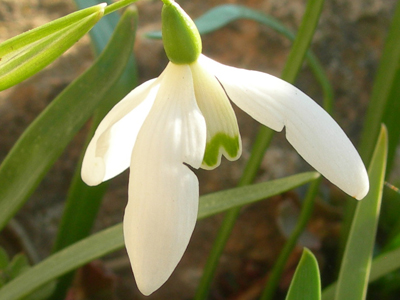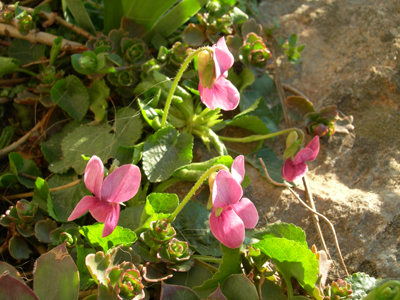Flora in Slovakia
There exist few records of various quaternary climate changes in the European territory. As well as in other countries, even in Slovakia these changes had an important impact on animal and plant species. Some species have survived while others died out. Many thermophilic species have widespread thorough our territory thanks to continuous climate warming.
Due to the continental temperate climate and nonhomogeneous geological subsoil conditions Slovakia has developed a unique and very rich flora. Slovakia extends on deciduous and mixed forests zones. Its flora is rich in mountain as well as thermophilic plant species. Thermophilic kinds grow mostly on the South of the country.


Slovakia has many forests. They extend on about 40% of its territory. They represent Slovakian greatest natural treasure. As they are popular place of relaxing, many tourists as well as natives frequently visit them. There also have been built many paths ideal for cyclotourism.
Lowland flora is as rich as the mountain one.
Vegetation in Slovakia
Vegetation changes can be observed with an increasing altitude. As climate factors have wide impact on the vegetation zoning, there can be distinguished several vegetation degrees. We recognize eight of them in Slovakia. Vegetation degrees are not separated by exact boundaries. One vegetation degree gradually passes to another one. Therefore the altitudes stated are only approximate.
Vegetation Degrees in Slovakia:
- Oak vegetation degree (100 – 400m a.s.l) (328 -1,173ft a.s.l)
- Beech – oak vegetation degree (200 – 550m a.s.l) (656 – 1,804ft a.s.l)
- Oak – beech vegetation degree (250 – 700m a.s.l) (820 – 2,296ft a.s.l)
- Beech vegetation degree (450 – 880m a.s.l) (1,476 – 2,887ft a.s.l)
- Fir – beech vegetation degree (650 – 1,050m a.s.l) (2,132 – 3,444ft a.s.l)
- Spruce – fir – beech vegetation degree (850 – 1,300m a.s.l) (2,788 – 4,265ft a.s.l)
- Spruce vegetation degree (1,100 – 1,550M a.s.l) (3,609 – 5,085ft a.s.l)
- Dwarf pine vegetation degree (1,450 – 1,900m a.s.l) (4,757 – 6,233ft a.s.l)
Flora of Lowland
Lowland flora of the hottest parts of Slovakia is represented by the vegetation growing in the Košice Basin, Záhorská, the Danubian and the Eastern Slovak lowlands. It is mainly represented by oak – hornbeam forests.
Oak, common lime, European weeping birch, maple, English walnut, hornbeam, European ash, black locust and hazelnut tree are also very frequent in these areas. Due to the man’s effort some tree kinds have moved to unusual places. Pine forests growing on Záhorská Lowland or spruce forests in areas situated at lower altitudes are good examples. River banks are bordered by flood-plain willow – alder forests. Usually they can be found at 250 – 300m a.s.l (820 – 984ft a.s.l). Bushy lowlands are also very rich in plant kinds: European elderberry, privet, English ivy, hawthorn, etc.
Herb species are represented by for example stinging nettle or deadnettle. Due to the man’s effort there can be found many gardens and orchards thorough Slovakian lowlands. People mostly plant: apple, pear, plum, cherry, sour cherry, apricot and peach trees. Raspberries and currants are quite popular among garden fruit bushes. Gardens are usually embellished with roses, daffodils, lilies and tulips. Well known vineyards can be found on sunny slopes for example in surroundings of Pezinok, Modra, Nitra, Viničky, etc.
Mountain Flora
Slovakian mountain flora is divided into several sub-regions: Little Carpathians, Považský Inovec, Tríbeč, Strážov Mountains, Fatra and Tatra mountain ranges and Slovak basins situated at higher altitudes.
Beech forests are very important in our country. They are typical for territories situated at higher altitudes. Even today the beech (Fagus silvatica) is the most frequent tree in Slovakia. Therefore it represents an important part of the Slovak ecosystem and plays a significant role in its stability.
Beech can be considered a part of Slovak cultural heritage as it is very important in meeting all optimal forest functions.
Other broadleaved tree kinds growing on the Slovak territory are: sessile oak, English oak, European alder, common hazel, European ash, European weeping birch, Eurasian aspen and field elm.
Coniferous forests can be found in areas extending above 1,000m a.s.l (3,280ft a.s.l). There can be found several kinds of coniferous trees: European silver fir, Norway spruce, European larch and several pine kinds: limba (Terminalia superba), European black pine, Scots pine and mountain pine. Zones reaching higher altitudes than coniferous forests are covered only by dwarf pine trees.
Flowery beech woods growing on steep limestone slopes are embellished by common limes or field maples. They are overgrown by bushes and herbs. Abundant ferns are also very frequent. Rocks are embellished by green and grey mosses and lichens. Mushroom pickers love searching shady nooks of the forest in search of our delicious mushrooms. Situated in eastern Slovakia, Bukovské vrchy (Bukovec Mountains) is a little mountain range belonging to the Eastern Carpathians. Its territory is overgrown by originally fir – beech forests characterized by a type of primaeval forest ecosystem.
The vegetation density is decreasing with growing altitude. Grassy uplands situated above dwarf pine zone can be found for example in upper parts of the High and the Low Tatras as well as the Greater and the Lesser Fatras. Areas reaching higher altitudes than grassy uplands are formed only by rocks covered with lichens and mosses. Mosses are usually growing in moister areas.
A separate group of woods is formed by flood-plain forests. They grow only along watercourses and they are not influenced by the elevation above sea level but by the underground water level. Continuous woods have been preserved along the Morava, Danube and Latorica rivers. The most common tree kinds on these territories are: alders, weeping willows and poplars. Spruces can be found in mountainous areas.
Slovakia is deservedly considered an important “crossing” of various flora components. Thanks to the environmental conditions and the position in the heart of Europe there can be found above forty endemic species on a relatively small territory. They are entirely or almost entirely bound to the Slovak territory.
The most widely known species are: Cyclamen fatrense, Daphne arbuscula, Pulsatilla slavica, Pulsatilla subslavica, Saxifraga wahlenbrgii, Soldanella carpatica and field pennycress (Thlaspi jankae). Our most well-known protected herbs are: Gentian clusii, pheasant’s eye, edelweiss and alpine aster. Slovakia is also home to an indefinite number of curative herbs. For example: coltsfoot, Pulmonaria officinalis, German camomile, English marigold, wild thyme, peppermint, etc.
Endemits and Relicts
Slovakia is very rich in protected and relic flora types. These preservations of previous geohistorical periods are for example pheasant’s eye or gentian clusii. Slovakia is also rich in endemic species (living only in bounded territories) as for example: Pulsatilla slavica, alpine aster or wallflowers as Erysimum wahlenbergii.
Arboretums in Slovakia
Natural botanical gardens as the one in Tesárske Mlyňany situated nearby Zlaté Moravce are very interesting not only for experts but also for all nature lovers. Due to the broad spectrum of evergreen foreign and domestic trees and bushes it belongs among the best arboretums in Slovakia.
Arboretum Kysihybeľ situated nearby Banská Štiavnica is characteristic by many kinds of coniferous and deciduous forest trees growing in the mild climate zone.
The largest Slovakian rosary is Borová hora located nearby Zvolen.
Agricultural Crops
Slovakia has well developed agricultural production. There are planted agricultural crops as: wheat, rye, barley, oat and corn. Lowlands are used for raising sugar beet, sunflower or oilseed rape. Higher situated fields are used for potato cultivation.



